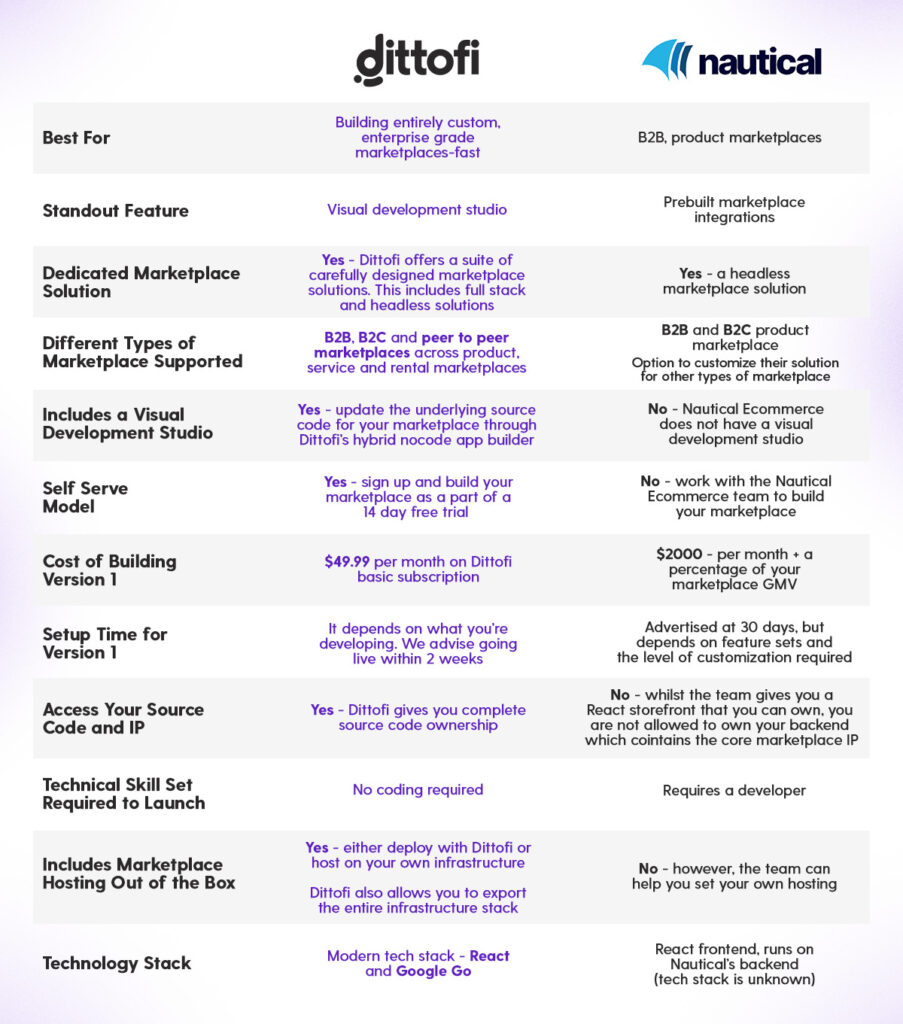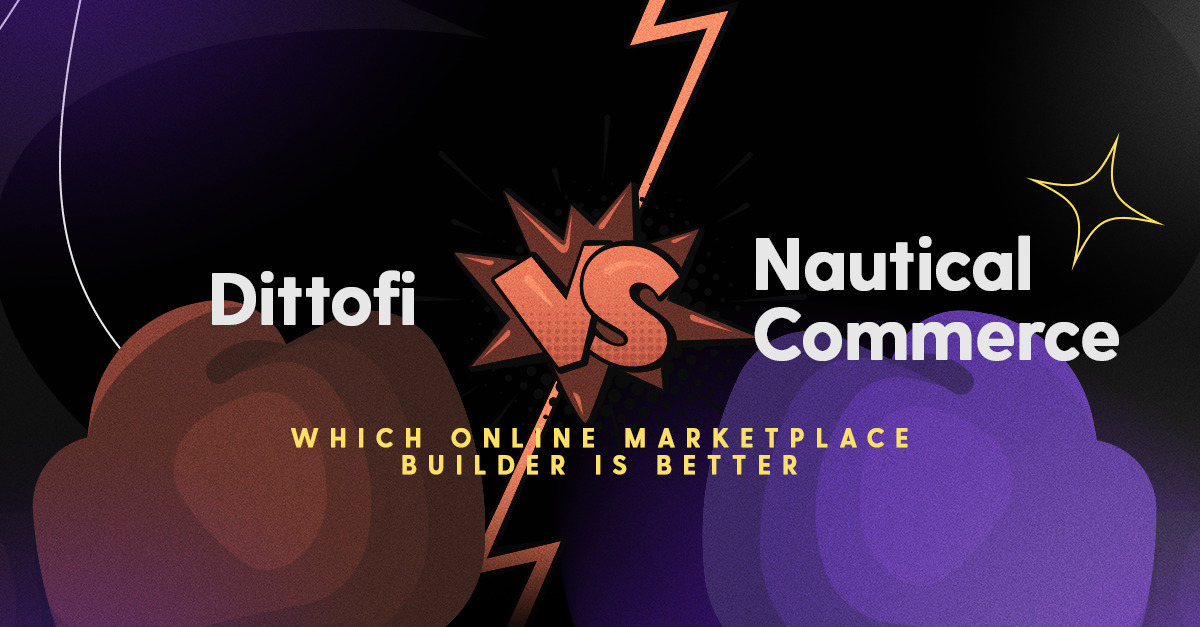What is the best way to build an online marketplace?
In this article we consider Dittofi’s no code marketplace solution as an alternative to Nautical Commerce multi-vendor marketplace solution.We start by looking at what Nautical Commerce is, who it is for and how much it costs.
What is Nautical Commerce?
Nautical Commerce is an API first, headless multi-vendor marketplace platform that focuses primarily on B2B product marketplaces.
For those who don’t know, a headless platform means that Nautical separates is deployed as a backend, that supports the features required for a multi-vendor marketplace however, you need to create your own frontend and plug this into Nautical’s backend.
Who is Nautical Commerce for?
Nautical Commerce has been built to help mid-sized and large businesses that want to build product based B2B and B2C marketplace platforms. The solution also partially caters for service marketplaces.
The solution does not have a self-serve model. Instead you’ll work with the Nautical Commerce engineering team over a 90 day period to build, launch and onboard your first marketplace businesses and consumers.
Nautical Commerce has also development partners who you can work with to build your marketplace.
How much does Nautical Commerce cost?
Nautical Commerce has two pricing models. One for SME and the other for enterprise.
For startups, the pricing begins at approximately $2000 per month plus a percentage of your marketplace Gross Merchandise Volume (GMV). Meanwhile enterprise pricing is split into bands, based on usage.
In addition to the platform spend, you should expect to spend between $15,000 – $30,000 per month on software developers to get the initial marketplace setup and for ongoing customization.
Dittofi vs Nautical Commerce at a glance
In this section we directly compare Dittofi as a Nautical Commerce alternative.

Dittofi as a Nautical Commerce alternative
To start thinking about Dittofi as a Nautical Commerce alternative, let’s begin by looking at the similarities between Dittofi and Nautical.
Similarities between Dittofi and Nautical Commerce
Both Dittofi and Nautical Commerce are both dedicated marketplace technologies that can be used to build various types of marketplace. Both platforms offer:
- Feature rich multi-vendor ecommerce marketplace solutions
- Allow you to build product based B2B or B2C marketplaces
- Are payment gateway agnostic
- Offer cloud agnostic services and out of the box marketplace hosting
Key differences between Dittofi and Nautical Commerce
Although there are some similarities between Dittofi and Nautical Commerce, there are also some quite major differences when it comes to the technical skills required to get setup, pricing, technology stack, marketplace hosting and intellectual property ownership and vendor lock-in.
Let’s take a look at each of these points below.
Technical skills required to get setup
Dittofi is a hybrid no code platform. This means that you can use Dittofi to build different types of marketplace without writing any code.
Using Dittofi you can setup your marketplace in hours using our self onboarding and, without the need to hire a developer.
Dittofi’s unique hybrid model combines no code and traditional code by translating all of your visual designs into enterprise grade code (React and Google Go). You can then access and edit your code through our visual development studio or export and hand it off to developers.
By contrast, Nautical Commerce gives you an API into their headless marketplace platform. This means that you need to hire a development team to build a frontend, plug this into the Nautical Commerce API and then maintain the code for your frontend. This approach can lead to steep development fees in the early stages and while you iterate on your marketplace idea.
To help lower the hurdle to getting started, Nautical offer you a prebuilt storefront that is already plugged into their API. This is developed in the programming language React and you can then give this to a developer to customize.
Types of marketplace: Dittofi vs Nautical Commerce
Dittofi is able to support more types of marketplace compared to Nautical.
Dittofi has specialized, template solutions for B2B, B2C and peer to peer marketplaces in the product, service or rental space. These solutions allow you to rapidly setup a marketplace, import products and services and start to onboard new users in hours – without the need for any developer involvement.
By contrast, Nautical Commerce is only has complete solutions for headless multi-vendor ecommerce platform for B2B and B2C marketplaces.
Pricing: Dittofi vs Nautical Commerce
Now, Nautical Commerce charges you two types of fees for your marketplace:
Fixed Monthly Platform Fee: This is like rent you pay to use their platform, regardless of how much business you do.
Percentage of Gross Merchandise Volume (GMV): GMV is just a fancy term for the total value of all the transactions that happen on your marketplace. So, if buyers and sellers transact $100 worth of goods in a month, your GMV is $100. Nautical Commerce takes a cut of this amount.
Now, here’s where it gets tricky. If your marketplace does well and more people buy and sell stuff, your GMV goes up. But since Nautical charges you a percentage of this GMV, your fees also increase. It’s like your landlord asking for more rent because your marketplace is getting busier.
The problem is, most marketplaces only keep a small percentage of their GMV as marketplace revenue. For instance they might make somewhere between 5% to 30% of their GMV as revenue. This means that Nautical’s fees are higher than then initially appear and this can put a strain on your business’s bottom line.
In contrast, Dittofi charges a fixed monthly fee for access to the visual development studio and hosting services. However, unlike Nautical Commerce’s model where fees increase along with your marketplace’s performance, Dittofi’s hosting fee only increases as you consume additional resources. This means you’re paying for what you use, ensuring cost efficiency and preventing you from overpaying for services you don’t need.
Moreover, as your marketplace expands, Dittofi offers you the freedom to export your entire codebase and infrastructure setup to your own hosting environment using Dittofi’s Automated Devops Solution (ADS).
This unprecedented level of flexibility empowers you to take control of your hosting costs by directly engaging with your hosting provider. Essentially, you’re not locked into Dittofi’s hosting services indefinitely, giving you the autonomy to manage your infrastructure in a way that best suits your evolving business needs.
Platform flexibility
Dittofi’s hybrid no-code platform empowers you to tailor your marketplace with the same flexibility as traditional coding, but without the time, cost, and complexity typically associated with custom development. This unique capability enables you to create a truly distinctive marketplace experience that sets you apart from competitors in areas such as user experience, payments, logistics and marketplace hosting.
In contrast, Nautical’s headless, API-first approach lacks this level of adaptability. While you can request new features from their development team, you’re constrained by their development roadmap and the uncertainty of when or if these features will be implemented. Additionally, once Nautical do decide to roll out the feature you request, it’s made available to the entire client base, diluting any competitive advantage it might have offered.
Intellectual property ownership and vendor lock-in
Nautical Commerce operates a 100% vendor lock-in model. They do not allow you to edit or own the underlying code for your marketplace.
By contrast Dittofi allows you to access, edit and own your marketplace source code and IP. This allows for more control, heavy duty customization to your marketplace and no risk of vendor lock-in.
There are several benefits to Dittofi’s approach vs Nautical’s. These include:
1. Code ownership allows for more innovation
There are many cases where marketplaces need granular code control in order to optimize core functionality within their marketplace and gain a competitive advantage. This can include optimizing features such as payments, back office logistics, your marketplace hosting and so on. Think about Amazon B2C marketplace for instance. Much of the IP is contained in the way they handle their logistics.
With Dittofi you have the option to own your code, with Nautical you don’t.
2. Code ownership gives you more control
Vendor lock-in occurs when the cost of switching systems becomes prohibitively high, making you entirely dependant on a particular vendor’s services or products. The dangers of vendor lock-in are significant. You can become entirely dependant on a third party vendor which reduces your negotiation power, limits your ability to innovate and can lead to higher costs compared to the competition.
Dittofi comes with zero vendor lock-in approach, Nautical comes with total vendor lock-in approach.
3. Flexibility in technology stack
With zero vendor lock-in, you have the freedom to choose and integrate different technologies and services that best suit your needs. This flexibility allows you to adapt to changing market conditions, technological advancements, and business requirements without being constrained by a single vendor’s offerings. For example, you can easily switch between hosting providers, payment gateways, or third-party integrations to optimize your marketplace’s performance and functionality.
Marketplace hosting
Dittofi gives you three options to host your marketplace.
- First, you can host on our prebuilt marketplace hosting model. This is an entirely scalable and serverless approach to marketplace hosting. For a list of the services check out our article how Dittofi hosts your marketplace applications.
- Second, you can export your marketplace source code and manually host this anywhere. Dittofi’s code is infrastructure agnostic and has been deployed on AWS, GCP and Azure.
- Third, Dittofi gives you the option to automatically deploy your marketplace into your own AWS account. This is done using Dittofi’s Automated Devops Solution (ADS). Dittofi ADS gives you a fully cloud native architecture at the push of a button. This can save teams more than $1 million in infrastructure development. The solution also gives you the flexibility to fully optimize your cloud as you scale.
In contrast to these approaches, Nautical Commerce, allows you to either:
- Host your marketplace on their infrastructure.
- Deploy their marketplace platform on-premise.
In both of these cases you have limited options for how to configure your marketplace hosting.
Conclusion: Build a unique marketplace
Nautical Commerce offers a feature-rich B2B and B2C marketplace. The platform is targeted primarily at mid to large cap companies. Nautical is venture-backed and sales-led. As such you need to speak with their sales team for a trial and quote.
In contrast, Dittofi is a hybrid no-code platform with marketplace technology for all types of marketplaces. The company is bootstrapped and product-led. As such you can sign up for a 14-day free trial to try the platform before purchasing.
As a product-led organization, Dittofi’s marketplace solution has been developed in collaboration its clients. These range from startups to enterprise and government entities. This method has allowed Dittofi to develop an innovative, feature-rich marketplace solution. The platform is appropriate for non-technical founders and engineering teams of all sizes.
Above all, Dittofi’s option to export and own your marketplace source code gives you a valuable asset for your business, without the risk of vendor lock-in.
Dittofi is therefore best for those who want to rapidly build entirely unique marketplaces. Other marketplace solutions that you may want to consider are CS-Cart or Sharetribe.
Become a Marketplace Insider
Join our inner circle for exclusive insights, coveted trade secrets, and unparalleled strategies – your journey to marketplace dominance begins here.

